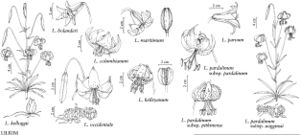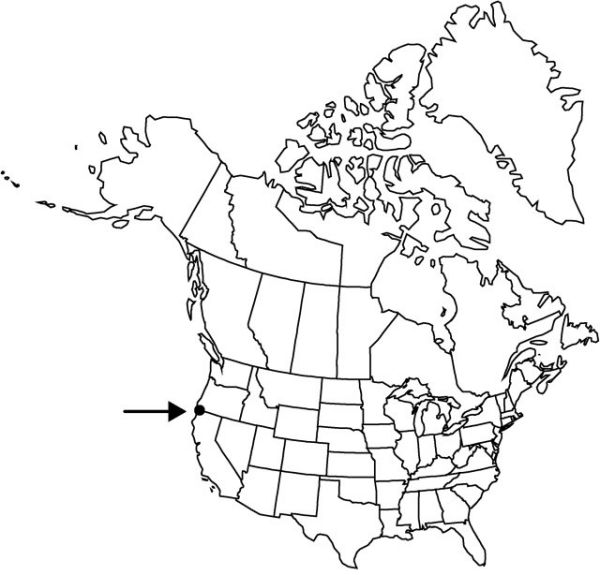Difference between revisions of "Lilium bolanderi"
Proc. Amer. Acad. Arts 20: 377. 1885.
FNA>Volume Importer |
FNA>Volume Importer |
||
| Line 27: | Line 27: | ||
|elevation=100–1500 m | |elevation=100–1500 m | ||
|distribution=Calif.;Oreg. | |distribution=Calif.;Oreg. | ||
| − | |discussion=<p>I. M. Johnston (1923) noted that Lilium bolanderi Watson was based on a mixed collection including L. kelloggii, and he argued that Watson intended the name to apply primarily to the latter species. Thus he proposed the name L. howellii for this diminutive, red-flowered, serpentine endemic. A. D. Cotton (1936) correctly concluded that Watson’s description applied primarily to the specimens here called L. bolanderi, and this view is now widely accepted.</p><!-- | + | |discussion=<p>I. M. Johnston (1923) noted that <i>Lilium bolanderi</i> Watson was based on a mixed collection including <i>L. kelloggii</i>, and he argued that Watson intended the name to apply primarily to the latter species. Thus he proposed the name L. howellii for this diminutive, red-flowered, serpentine endemic. A. D. Cotton (1936) correctly concluded that Watson’s description applied primarily to the specimens here called <i>L. bolanderi</i>, and this view is now widely accepted.</p><!-- |
| − | --><p>Lilium bolanderi hybridizes with L. rubescens, L. washingtonianum subsp. purpurascens, and subspecies of L. pardalinum.</p><!-- | + | --><p><i>Lilium bolanderi</i> hybridizes with <i>L. rubescens</i>, <i>L. washingtonianum </i>subsp.<i> purpurascens</i>, and subspecies of <i>L. pardalinum</i>.</p><!-- |
--><p>Bolander’s lily is primarily pollinated by Allen’s and rufous hummingbirds (Selasphorus spp., family Trochilidae).</p> | --><p>Bolander’s lily is primarily pollinated by Allen’s and rufous hummingbirds (Selasphorus spp., family Trochilidae).</p> | ||
|tables= | |tables= | ||
| Line 53: | Line 53: | ||
|publication year=1885 | |publication year=1885 | ||
|special status= | |special status= | ||
| − | |source xml=https://jpend@bitbucket.org/aafc-mbb/fna-data-curation.git/src/ | + | |source xml=https://jpend@bitbucket.org/aafc-mbb/fna-data-curation.git/src/8f726806613d60c220dc4493de13607dd3150896/coarse_grained_fna_xml/V26/V26_313.xml |
|genus=Lilium | |genus=Lilium | ||
|species=Lilium bolanderi | |species=Lilium bolanderi | ||
Revision as of 17:43, 18 September 2019
Bulbs ± ovoid, 3.5–7.9 × 2.6–5.3 cm, 0.9–2.1 times taller than long; scales unsegmented, longest 3–5.7 cm; stem roots absent. Stems to 1.1 m, glaucous. Buds rounded in cross section. Leaves in 1–5(–6) whorls or partial whorls, 3–19 leaves per whorl, ascending and often cupping stem, 1.8–7.1 × 0.7–2.8 cm, 2.2–4.8 times longer than wide; blade ± obovate, oblanceolate, or occasionally elliptic, noticeably glaucous, margins nearly always undulate, apex widely acute; veins and margins ± smooth abaxially. Inflorescences usually umbellate in small plants, in large plants racemose or in 2 whorls, 1–9-flowered. Flowers nodding to horizontal, not fragrant; perianth ± campanulate or funnelform; sepals and petals somewhat recurved 3/5–4/5 along length from base, red or magenta, occasionally salmon pink or pale yellow, with maroon spots, often yellowish on proximal 1/3–1/2, not distinctly clawed; sepals not ridged abaxially, 3.1–4.7 × 0.7–1.2 cm; petals 3–4.5 × 0.7–1.1 cm; stamens included; filaments barely spreading, diverging 0°–12° from axis; anthers reddish or magenta, 0.3–0.8 cm; pollen rust, orange, or yellow; pistil 2.1–3.5 cm; ovary 1–2.1 cm; style green, rarely reddish purple; pedicel 0.8–14.2 cm. Capsules 2–4.1 × 1.2–2.1 cm, 1.4–3 times longer than wide. Seeds 90–210. 2n = 24.
Phenology: Flowering summer (mid Jun–mid Aug).
Habitat: Dry serpentine soils in chaparral, gaps in open mixed conifer or Douglas-fir [Pseudotsuga menziesii (Mirbel) Franco] forests, associated with bear-grass [Xerophyllum tenax (Pursh) Nuttall]
Elevation: 100–1500 m
Discussion
I. M. Johnston (1923) noted that Lilium bolanderi Watson was based on a mixed collection including L. kelloggii, and he argued that Watson intended the name to apply primarily to the latter species. Thus he proposed the name L. howellii for this diminutive, red-flowered, serpentine endemic. A. D. Cotton (1936) correctly concluded that Watson’s description applied primarily to the specimens here called L. bolanderi, and this view is now widely accepted.
Lilium bolanderi hybridizes with L. rubescens, L. washingtonianum subsp. purpurascens, and subspecies of L. pardalinum.
Bolander’s lily is primarily pollinated by Allen’s and rufous hummingbirds (Selasphorus spp., family Trochilidae).
Selected References
None.

